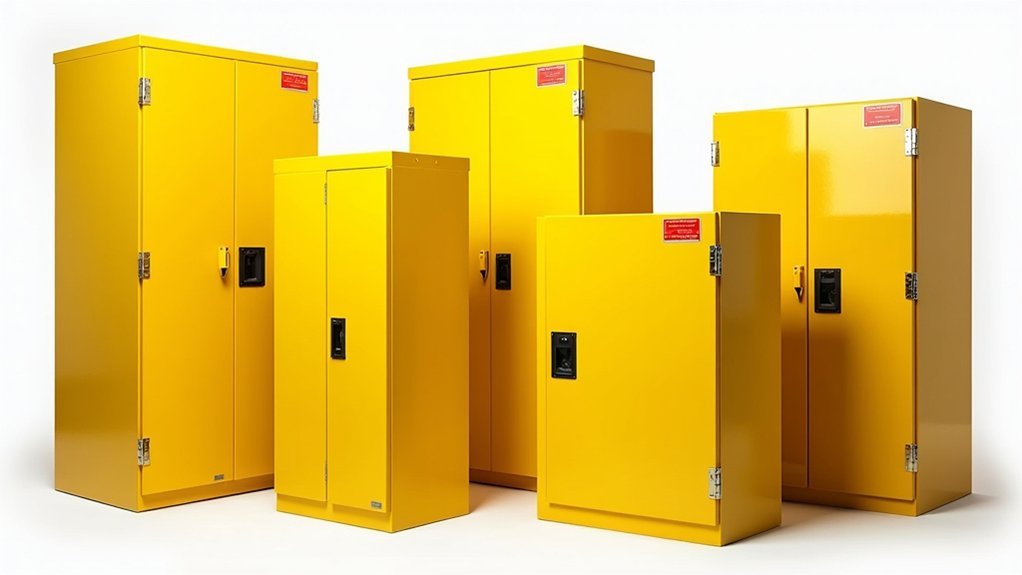You’re dealing with hazardous materials, and you need storage solutions that won’t compromise safety or compliance. The wrong cabinet can lead to dangerous leaks, fire hazards, or regulatory violations that’ll cost you far more than the initial investment. Whether you’re storing flammable liquids, corrosive chemicals, or other dangerous substances, choosing the right cabinet isn’t just about capacity—it’s about protecting your workspace and meeting strict safety standards that could save lives.
Vevor Flammable Cabinet, Galvanized Steel Safety Cabinet
The Vevor Flammable Cabinet’s double-walled galvanized steel construction makes it an ideal choice if you need reliable fire protection for your hazardous materials storage. You’ll appreciate its 50mm leak-proof sump that prevents spills and meets OSHA standards. The cabinet features a three-point locking system for security and two vents for proper airflow. Its all-welded body without rivets guarantees durability against rust, dents, and chemicals. You’ll get an adjustable galvanized shelf, reflective warning labels, and grounding conductor for anti-static protection. While some customers report shipping damage and door latch issues, most praise its excellent build quality and packaging.
Best For: Businesses and facilities that need to safely store flammable liquids and hazardous materials while meeting OSHA and EPA compliance standards.
Pros:
- Double-walled galvanized steel construction with fire-resistant design and leak-proof 50mm sump for maximum safety
- All-welded body construction without rivets provides superior durability against rust, dents, and chemical damage
- Includes comprehensive safety features like three-point locking system, proper ventilation, reflective warning labels, and anti-static grounding
Cons:
- Some units arrive with shipping damage including dents and door alignment issues
- Door latch mechanism has reported failure problems affecting security and functionality
- Instruction manual has translation issues that can make assembly and setup more difficult
Koxuyim Hazardous Storage Safety Cabinet with Adjustable Galvanized Steel Shelves
Laboratories and industrial facilities requiring robust hazardous material storage will find the Koxuyim Hazardous Storage Safety Cabinet an exceptional choice for managing flammable liquids and chemicals. You’ll get 12-24 gallons of storage capacity within its double-wall steel construction featuring 1.2mm thick plates for superior fire resistance. The cabinet’s all-welded design eliminates weak points from rivets or screws, while two adjustable galvanized shelves accommodate various container sizes. You can secure contents using the three-point linkage door lock system, with optional padlock capability for enhanced protection. Meeting ROHS, CE, and OSHA standards, it’s suitable for hospitals, workshops, chemical plants, and laboratory environments.
Best For: Laboratories, industrial facilities, hospitals, and chemical plants that need OSHA-compliant storage for flammable liquids and hazardous chemicals with reliable fire resistance and security features.
Pros:
- All-welded double-wall steel construction with 1.2mm thick plates provides superior durability and fire resistance without weak points from rivets or screws
- Meets multiple safety standards (ROHS, CE, and OSHA) ensuring compliance for professional and industrial environments
- Three-point linkage door lock with optional padlock capability and adjustable galvanized shelves offer excellent security and storage flexibility
Cons:
- At 63.3 lbs, the cabinet is quite heavy and may require assistance for installation and positioning
- Manual closing doors lack automatic closing mechanisms that some safety regulations may prefer for enhanced fire protection
- Limited to 12-24 gallon capacity which may be insufficient for larger industrial operations with extensive chemical storage needs
LOYALHEARTDY 12 Gallon Flammable Storage Cabinet
Compact workspaces and budget-conscious facilities will find the LOYALHEARTDY 12 Gallon Flammable Storage Cabinet delivers essential safety features in a space-efficient design. At 17x17x22 inches, you’ll maximize storage while minimizing footprint. The cold-rolled steel construction includes leak-proof sump protection and side ventilation holes for safe chemical storage. You can secure contents with the aluminum alloy lock cylinder or add padlocks for extra security. The adjustable galvanized shelf accommodates various container sizes and resists corrosion. With 350-pound weight capacity and 30+ minutes fire prevention time, you’re getting reliable hazardous material storage for laboratories, workshops, or home use at competitive pricing.
Best For: Budget-conscious facilities, compact workspaces, laboratories, workshops, and home users who need essential flammable storage safety features in a space-efficient design.
Pros:
- Compact 17x17x22 inch footprint maximizes storage while minimizing workspace requirements
- Comprehensive safety features including leak-proof sump, side ventilation, and 30+ minute fire prevention time
- Versatile locking options with aluminum alloy cylinder lock and additional padlock capability for enhanced security
Cons:
- Mixed customer reviews indicate potential quality control issues with some units arriving damaged
- Limited 12-gallon capacity may be insufficient for larger operations or extensive chemical storage needs
- Single manual closing door design lacks the convenience of self-closing mechanisms found in higher-end models
30 Gallon Flammable Safety Cabinet for Chemical Storage
Facilities handling significant quantities of flammable chemicals need robust storage solutions that won’t compromise under pressure. This 30-gallon cabinet delivers exactly that with fireproof double-layer 14GA cold-rolled steel construction and powder-coated finish for corrosion resistance. You’ll get secure storage through its 3-point locking system, while the built-in ventilation prevents hazardous fume buildup. The adjustable shelves accommodate various container sizes, and self-closing doors with grounding connections guarantee regulatory compliance. At 18x18x35 inches, it’s compact yet spacious enough for substantial chemical inventories. Warning labels and safety features make this cabinet ideal for facilities requiring dependable hazardous material storage.
Best For: Facilities, laboratories, and industrial workplaces that need compliant, secure storage for flammable chemicals and hazardous materials with regulatory safety requirements.
Pros:
- Fireproof double-layer 14GA cold-rolled steel construction with powder-coated finish provides exceptional durability and corrosion resistance
- 3-point locking system and built-in ventilation system ensure secure storage while preventing dangerous fume buildup
- Self-closing doors, grounding connections, and warning labels meet regulatory compliance standards for workplace safety
Cons:
- 30-gallon capacity may be insufficient for facilities with large chemical inventories requiring bulk storage
- Compact 18x18x35 inch footprint limits the size of containers that can be stored on adjustable shelves
- Higher upfront cost compared to basic storage cabinets without specialized safety features and fireproof construction
VEVOR 45 Gal Flammable Liquid Storage Cabinet with 2 Adjustable Shelves
When you’re managing large volumes of flammable materials in industrial settings, the VEVOR 45 Gal Flammable Liquid Storage Cabinet delivers the robust capacity and safety features you need. This 246-pound cabinet features Q235 cold-rolled steel construction with a fully welded body that meets FM-approved NFPA Code 30 and OSHA standards.
You’ll appreciate the thorough safety design, including ventilation holes that reduce volatile gas buildup, a collecting tank that prevents harmful leaks, and a grounding conductor that minimizes static electricity. The 3-point locking system enhances security, while the 180-degree door opening provides easy access to your stored materials.
Two adjustable galvanized steel shelves accommodate various container heights, making organization simple and efficient for your hazardous materials storage needs.
Best For: Industrial facilities, manufacturing plants, and workshops that need compliant storage for large volumes of flammable liquids like gasoline, alcohol, and adhesives.
Pros:
- Meets FM-approved NFPA Code 30 and OSHA standards with comprehensive safety features including ventilation, leak collection, and grounding conductor
- Robust Q235 cold-rolled steel construction with fully welded body and galvanized shelves for long-lasting durability in demanding environments
- Large 45-gallon capacity with two adjustable shelves and 180-degree door opening for efficient organization and easy access
Cons:
- Extremely heavy at 246 pounds, making installation and relocation challenging
- Limited customer feedback with only 9 ratings and moderate 3.8-star rating
- High price point may not be cost-effective for smaller operations with limited storage needs
Factors to Consider When Choosing Storage Cabinets for Hazardous Materials
When you’re selecting a hazardous materials storage cabinet, you’ll need to evaluate several critical features that directly impact safety and compliance. Material construction quality and fire resistance standards form the foundation of any reliable cabinet, while storage capacity requirements must align with your specific needs. You’ll also want to examine the ventilation system design and locking security features to guarantee proper containment and authorized access control.
Material Construction Quality
Since hazardous materials can corrode, ignite, or damage inferior storage solutions, you’ll want to prioritize cabinets constructed from high-grade materials like galvanized steel or cold-rolled steel. These materials offer superior durability and resistance to rust, dents, and chemical exposure.
Look for double-walled designs with air gaps, which slow heat transfer during fires and enhance safety protection. You should choose all-welded structures without rivets, screws, or tack welds, as these provide greater robustness and reduce structural failure risks over time.
Steel thickness matters greatly—cabinets with thicker plates like 1.2 mm offer better fire resistance than thinner alternatives. Finally, powder-coated finishes boost corrosion resistance, extending your cabinet’s service life while maintaining its appearance in demanding environments.
Fire Resistance Standards
Fire resistance standards represent the backbone of safe hazardous material storage, determining whether your cabinet can protect its contents and surrounding areas during emergencies. You’ll need cabinets with double-walled construction featuring a 1-1/2 inch air gap to minimize heat transfer effectively. Look for units that withstand fire exposure for over 30 minutes, giving you essential evacuation time. Make certain your cabinet meets OSHA and EPA regulations, as compliance isn’t optional—it’s mandatory for safe operations. Seek FM or UL certification, which confirms the cabinet meets rigorous fire safety criteria. Don’t overlook proper ventilation systems that prevent flammable vapor buildup. These standards work together to prevent ignition of stored materials and protect your facility from catastrophic fire damage.
Storage Capacity Requirements
Determining your storage capacity requirements starts with calculating the total volume of hazardous materials you’ll need to store, as cabinets typically range from 12 to 45 gallons for most applications. You’ll want to choose a cabinet whose capacity matches or exceeds your expected volume to guarantee adequate storage space.
Look for cabinets with adjustable shelves that accommodate different container sizes while maximizing vertical space efficiency. Consider the physical dimensions carefully to make certain the cabinet fits your available storage area while allowing proper access and ventilation clearance.
Compliance with OSHA and EPA standards often dictates minimum capacity requirements, so verify your cabinet meets regulatory standards. Additionally, select cabinets featuring leak-proof sumps and proper ventilation systems to effectively manage spills and fumes without compromising storage capacity.
Ventilation System Design
Effective ventilation systems prevent dangerous vapor accumulation that can turn your storage area into a safety hazard. You’ll need multiple vents that promote consistent airflow to dissipate harmful fumes and maintain safe air quality within your cabinet. Look for cabinets with side ventilation holes or dedicated ventilation systems that meet OSHA compliance standards.
Consider double-walled designs with 1-1/2 inch air gaps, which provide heat resistance and slow fire spread by reducing heat transfer. These systems don’t just enhance safety—they’ll extend your cabinet’s lifespan by minimizing internal corrosion from chemical vapors. Proper ventilation guarantees you’re meeting regulatory requirements while protecting both your materials and personnel from volatile gas buildup that could create catastrophic conditions.
Locking Security Features
While ventilation protects against vapor hazards, you’ll need robust locking mechanisms to prevent unauthorized access to your dangerous materials. Three-point locking systems provide superior security by engaging multiple contact points, making forced entry considerably more difficult than single-point locks.
Look for cabinets constructed with high-quality aluminum alloy locking components that resist tampering and break-ins. Many models offer dual security through additional padlock compatibility, giving you extra protection for highly sensitive substances.
Choose cabinets with manual closing doors that automatically engage the locking mechanism when shut, ensuring you won’t accidentally leave materials unsecured. Remember that OSHA compliance often requires effective locking systems, so verify your chosen cabinet meets regulatory standards for safely storing flammable and hazardous substances in your workplace.
Compliance Certifications Needed
When selecting hazardous materials storage cabinets, you must verify they carry the proper compliance certifications to meet legal requirements and guarantee workplace safety. OSHA standards are fundamental, requiring proper labeling and construction that secures worker protection. You’ll also need ROHS and CE certifications, which demonstrate adherence to European Union environmental and safety regulations.
For flammable materials, explosion protection certificates are essential—they confirm your cabinet can withstand specific hazardous conditions. Fire safety compliance is equally important, particularly NFPA Code 30 standards that dictate construction guidelines minimizing fire risks.
Don’t overlook ongoing compliance requirements. You must schedule regular inspections and compliance audits to confirm your storage cabinets continue meeting established safety standards over time, maintaining their certification validity.
Leak Prevention Capabilities
Beyond certification requirements, leak prevention capabilities form the backbone of any reliable hazardous materials storage system. You’ll want cabinets featuring leak-proof sumps that contain spills and meet OSHA and EPA standards. Look for models with drain holes in the sump to facilitate easy cleaning and maintenance.
Construction materials matter considerably. Choose cabinets made from galvanized steel, which offers superior durability and resistance against rust and chemical damage. You’ll also need adjustable shelves with anti-corrosion coatings that remain intact under pressure from stored materials.
Don’t overlook proper ventilation systems. They’re essential for preventing hazardous fume buildup, indirectly contributing to leak prevention by ensuring potential leaks don’t accumulate harmful gases within the cabinet.
Installation Space Considerations
Since proper installation determines both safety and functionality, evaluating your available space becomes critical before selecting any hazardous materials storage cabinet. You’ll need to measure your installation area’s dimensions carefully, accounting for both height and width restrictions to guarantee your chosen cabinet fits comfortably.
Don’t forget to plan for adequate clearance around the cabinet. Most models require extra space for proper air circulation and maintenance access. You’ll also want to verify your floor can handle the cabinet’s weight, as some units are quite heavy and could affect structural integrity.
Consider proximity to heat sources or flammable materials when choosing your location. Keep cabinets away from potential fire hazards. Finally, check local regulations regarding hazardous material storage installations, which often mandate specific spacing and location requirements.
Frequently Asked Questions
What Safety Certifications Should I Look for in Hazardous Material Storage Cabinets?
You’ll want FM Approved or UL Listed certifications for fire safety. Look for OSHA compliance markings and EPA approvals for chemical storage. Don’t forget NFPA standards certification for proper ventilation and containment requirements.
How Often Should Hazardous Material Storage Cabinets Be Inspected for Safety Compliance?
You should inspect your hazardous material storage cabinets monthly for basic safety checks, quarterly for detailed assessments, and annually for thorough compliance audits to guarantee they’re meeting all regulatory requirements.
Can Different Types of Hazardous Chemicals Be Stored Together in One Cabinet?
You shouldn’t store incompatible chemicals together in one cabinet. Different hazardous materials can react dangerously, causing fires, explosions, or toxic gases. Always separate acids, bases, oxidizers, and flammables into designated cabinets.
What Is the Proper Way to Dispose of Damaged Hazardous Material Storage Cabinets?
You’ll need to contact your local hazardous waste facility or environmental agency for proper disposal guidelines. Don’t attempt disposal yourself – these cabinets require specialized handling due to potential contamination.
Are There Specific Ventilation Requirements for Rooms Containing Hazardous Material Storage Cabinets?
You’ll need adequate ventilation systems that provide proper air exchanges per hour, maintain negative pressure, and include exhaust systems. Check your local fire codes and OSHA standards for specific requirements.





Leave a Reply